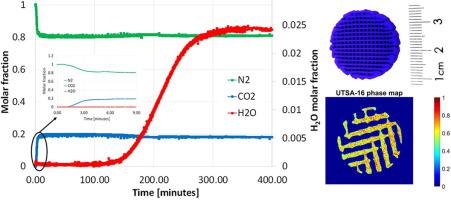Chemical Engineering Journal ( IF 15.1 ) Pub Date : 2020-07-08 , DOI: 10.1016/j.cej.2020.126166 Carlos A. Grande , Richard Blom , Vesna Middelkoop , Dorota Matras , Antonis Vamvakeros , Simon D.M. Jacques , Andrew M. Beale , Marco Di Michiel , Kari Anne Andreassen , Aud M. Bouzga

|
Structuring MOF materials is a fundamental step towards their commercialization. Herein we report intensive characterization of 3D-printed UTSA-16 monoliths, facilitated by the development of a new non-aqueous ink formulation, employing hydroxypropyl cellulose and boehmite to adjust the rheology of the ink. What makes this formulation and printing process different from the printed adsorbents and catalysts published previously, is that the resulting structures in this work were not sintered. The presence of the binder matrix not only produced the physical properties for printability but also ensured a homogeneous dispersion of UTSA-16 in the structures, as well as gas adsorption characteristics. The monoliths were tested for the adsorption of different gases (N2, CH4, CO2 and H2O) in order to apply them into separation processes that contribute to defossilizing energy and fuels production. Water is strongly adsorbed in this material (~14 mol/kg at 293 K) and is competing with CO2 for adsorption sites. Breakthrough curves showed that the retention time of CO2 decreases significantly when the feed stream is saturated with water. In this study, synchrotron XRD-CT data were collected in situ, in a non-destructive way, and phase distribution maps were reconstructed to, for the first time, gain insight into the spatial and temporal evolution of the UTSA-16 containing phases in the operating 3D printed monolith during the exposure to CO2.
中文翻译:

新型3D打印UTSA-16结构的吸附性能的多尺度研究
结构化MOF材料是实现其商业化的基本步骤。本文中,我们报告了3D打印的UTSA-16整体材料的深入表征,这得益于开发了一种新的非水性油墨配方,该配方采用羟丙基纤维素和勃姆石来调节油墨的流变性。使这种配方和印刷工艺不同于先前出版的印刷的吸附剂和催化剂的原因在于,这项工作中得到的结构没有被烧结。粘合剂基质的存在不仅产生了可印刷性的物理性质,而且确保了UTSA-16在结构中的均匀分散以及气体吸附特性。测试了整料对不同气体(N 2,CH 4,CO 2和H 2 O),以将其应用于有助于使能源和燃料生产脱化石的分离过程。水被这种材料强烈吸附(在293 K下约为14 mol / kg),并且与CO 2竞争吸附位置。突破曲线表明,当进料流被水饱和时,CO 2的保留时间显着减少。在这项研究中,同步加速器XRD-CT数据以一种非破坏性的方式就地收集,并且重建了相分布图,以首次了解包含UTSA-16的相的时空演化。在暴露于CO 2期间运行的3D打印整料。


























 京公网安备 11010802027423号
京公网安备 11010802027423号